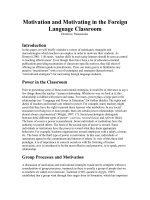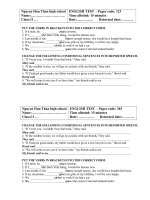Including Files and Applets in JSP Pages
Bạn đang xem bản rút gọn của tài liệu. Xem và tải ngay bản đầy đủ của tài liệu tại đây (1.03 MB, 16 trang )
© 2010 Marty Hall
Including Files
and
Including
Files
and
Applets in JSP Pages
Ori
g
inals of Slides and Source Code for Examples:
/>Customized Java EE Training: />Servlets, JSP, JSF 2.0, Struts, Ajax, GWT 2.0, Spring, Hibernate, SOAP & RESTful Web Services, Java 6.
Developed and taught by well-known author and developer. At public venues or onsite at your location.
2
© 2010 Marty Hall
For live Java EE training, please see training courses
at
at
Servlets, JSP, Struts, JSF 1.x, JSF 2.0, Ajax (with jQuery, Dojo,
Prototype, Ext-JS, Google Closure, etc.), GWT 2.0 (with GXT),
Java 5, Java 6, SOAP-based and RESTful Web Services, Sprin
g
,
g
Hibernate/JPA, and customized combinations of topics.
Taught by the author of Core Servlets and JSP, More
Servlets and JSP
and this tutorial Available at public
Customized Java EE Training: />Servlets, JSP, JSF 2.0, Struts, Ajax, GWT 2.0, Spring, Hibernate, SOAP & RESTful Web Services, Java 6.
Developed and taught by well-known author and developer. At public venues or onsite at your location.
Servlets and JSP
,
and this tutorial
.
Available at public
venues, or customized versions can be held on-site at your
organization. Contact for details.
Agenda
• <jsp:include page="…"/>
– Using jsp:include to include pages at request time
• <%@ include file="…" %>
– Using <%@ include %> (the include directive)
to include files at page translation time
• Usage
– Understanding why jsp:include is usually better than
th i l d di ti
th
e
i
nc
l
u
d
e
di
rec
ti
ve
• Applets
Ui
jli
ti ld ltf thJ
–
U
s
i
ng
j
sp:p
l
ug
i
n
t
o
i
nc
l
u
d
e app
l
e
t
s
f
or
th
e
J
ava
Plug-in (rare!)
4
Including Pages at Request
Time:
jsp:include
Time:
jsp:include
• Format
– <
j
sp:include
p
age="Relative address" />
• Purpose
T JSPHTML litt tt
–
T
o reuse
JSP
,
HTML
, or p
l
a
i
n
t
ex
t
con
t
en
t
– To permit updates to the included content without
changing the main JSP page(s)
• Notes
– JSP content cannot affect main page:
onl
tt
of incl ded JSP page is sed
onl
y ou
t
pu
t
of
incl
u
ded
JSP
page
is
u
sed
– Don’t forget that trailing slash
– Relative URLs that starts with slashes are inter
p
reted
p
relative to the Web app, not relative to the server root.
– You are permitted to include files from WEB-INF
5
jsp:include Example: A News
Headline Page (Main Page)
Headline
Page
(Main
Page)
…
<BODY>
<BODY>
<TABLE BORDER=5 ALIGN="CENTER">
<TR><TH CLASS="TITLE">
What
'
s New at JspNews com</TABLE>
What s
New
at
JspNews
.
com</TABLE>
<P>
Here is a summary of our three
most recent news stories:
most
recent
news
stories:
<OL>
<LI><jsp:include page="/WEB-INF/includes/Item1.jsp" />
<
LI
>
<
j
s
p
:include
p
a
g
e="
/
WEB-INF
/
includes
/
Item2.
j
s
p
"
/>
jp
pg /
//jp/
<LI><jsp:include page="/WEB-INF/includes/Item3.jsp" />
</OL>
<
/BODY></HTML
>
6
A News Headline Page,
Continued (First Included Page)
Continued
(First
Included
Page)
<B>Bill Gates acts humble.</B> In a startling
and unexpected development Microsoft big wig
and
unexpected
development
,
Microsoft
big
wig
Bill Gates put on an open act of humility
yesterday.
// /
<A HREF="http:
//
www.microsoft.com
/
Never.html"
>
More details </A>
–
N
ote that the
p
a
g
e is no
t
a com
p
lete HTML document
;
it
pg
p;
has only the tags appropriate to the place that it will be
inserted
7
A News Headline Page: Result
8
The jsp:param Element:
Augmenting Request Parameters
Augmenting
Request
Parameters
• Code
<
jsp:include page="/fragments/StandardHeading.jsp">
<jsp:param name="bgColor" value="YELLOW" />
</jsp:include>
• URL
– http://host/path/MainPage.jsp?fgColor=RED
Mi
•
M
a
i
n page
– fgColor: RED
bgColor: null
–
bgColor:
null
• Regardless of whether you check before or after inclusion
• Included
p
a
g
e
pg
– fgColor: RED
– bgColor: YELLOW
9
Including Files at Page Translation
Time: <%@ include %>
Time:
<%@
include
…
%>
• Format
<%@ i l d fil "R l ti dd " %>
–
<%@
i
nc
l
u
d
e
fil
e=
"R
e
l
a
ti
ve a
dd
ress
"
%>
• Purpose
– To reuse JSP content in multi
p
le
p
a
g
es
,
where JSP
ppg,
content affects main page
• Notes
Servers are not required to detect changes to the included
–
Servers
are
not
required
to
detect
changes
to
the
included
file, and in practice they don’t.
– Thus, you need to change the JSP files whenever the
included file changes
included
file
changes
.
– You can use OS-specific mechanisms such as the Unix
“touch” command, or
• <% Navbar.jsp modified 4/1/09 %>
<%@ include file="Navbar.jsp" %>
10
jsp:include vs.
<%@ include >
<%@
include
…
>
jsp:include <%@ include …%>
Basic s
y
ntax
<
j
sp:include pa
g
e=" " />
<%
@
include file=" " %>
When inclusion
occurs
Request time Page translation time
occurs
What is included
Output of page Contents of file
Number of resulting
l
Two One
serv
l
ets
Can included page set
response headers that
affect the main page?
No Yes
affect the main page?
Can included page
define fields or methods
that main page uses?
No Yes
11
Does main page need to
be updated when
included page changes?
No Yes
Which Should You Use?
• Use jsp:include whenever possible
– Changes to included page do not require any
manual updates
–
Speed difference between jsp:include and the include
–
Speed
difference
between
jsp:include
and
the
include
directive (@include) is insignificant
• The include directive
(
<%
@
include …%>
)
(@ )
has additional power, however
– Main page
<%! i t
Ct
0%>
•
<%!
i
n
t
access
C
oun
t
=
0
;
%>
– Included page
• <%@ include file="snippet.jsp" %>
• <%= accessCount++ %>
12
Include Directive Example:
Reusable Footers
Reusable
Footers
<%@ page import="java.util.Date" %>
<%
The following become fields in each servlet that
<%
The
following
become
fields
in
each
servlet
that
results from a JSP page that includes this file. %>
<%!
private int accessCount = 0;
private Date accessDate = new Date();
private String accessHost = "<I>No previous access</I>";
%>
<P>
<P>
<HR>
This page © 2008
<A HREF="http//www.my-company.com/">my-company.com</A>.
This page has been accessed <%= ++accessCount %>
times since server reboot. It was most recently
accessed from
<%
Ht
%> t <%
Dt
%>
<%
= access
H
os
t
%>
a
t
<%
= access
D
a
t
e
%>
.
<% accessHost = request.getRemoteHost(); %>
<% accessDate = new Date(); %>
13
Reusing Footers:
Typical Main Page
Typical
Main
Page
…
<BODY>
<BODY>
<TABLE BORDER=5 ALIGN="CENTER">
<TR><TH CLASS="TITLE">
Some Random Page</TABLE>
Some
Random
Page</TABLE>
<P>
Information about our products and services.
<P>
<P>
Blah, blah, blah.
<P>
Ydddddd
Y
a
dd
a, ya
dd
a, ya
dd
a.
<%@ include file="/WEB-INF/includes/ContactSection.jsp" %>
</BODY></HTML>
14
Reusing Footers: Result
15
Understanding jsp:include vs.
<%@ include %>
<%@
include
…
%>
• Footer defined the accessCount field
(i ibl)
(i
nstance var
i
a
bl
e
)
If i d C t th
•
If
ma
i
n pages use
d
access
C
oun
t
,
th
ey
would have to use @include
Otherwise accessCount would be undefined
–
Otherwise
accessCount
would
be
undefined
• In this exam
p
le
,
the main
p
a
g
e did not use
p, pg
accessCount
– So why did we use @include?
16
© 2010 Marty Hall
Applets and
j
sp:plugin
Customized Java EE Training: />Servlets, JSP, JSF 2.0, Struts, Ajax, GWT 2.0, Spring, Hibernate, SOAP & RESTful Web Services, Java 6.
Developed and taught by well-known author and developer. At public venues or onsite at your location.
17
Why Applets?
• When UI requirements demand it
– When HTML (even with Ajax) cannot support GUI
• Major drawbacks
Mb lkJ
–
M
any
b
rowsers
l
ac
k
J
ava support
• So, your Web page will have severely limited audience
– A
pp
let
p
ro
g
rammin
g
relativel
y
tedious
pp p g g y
• Alternatives
– Consider Flash or even Silverlight instead
– The fact that you are using Java on the server should not
make you any more likely to use Java on the client!
jsp:include
is very important part of JSP
jsp:plugin
is not
–
jsp:include
is
very
important
part
of
JSP
.
jsp:plugin
is
not
• Skip this entire tutorial section if you do not plan on using
applets
18
Options for Deploying Applets
• Support for very old browsers
Dl
th l t ith JDK 1 1
102
–
D
eve
l
op
th
e app
l
e
t
s w
ith
JDK
1
.
1
or even
1
.
02
• Works with almost any browser that has Java installed
• Uses the simple APPLET tag
Stfdtlldb
•
S
uppor
t
f
or mo
d
era
t
e
l
y o
ld
b
rowsers
– Have users install any version of the Java 2 Plug-in, then
use Java 2 for the applets.
• Works with almost any browse
r
• Uses ugly OBJECT and EMBED tags
• This second option simplified by the jsp:plugin tag
• Support for recent browsers
– Have users install version 5 or 6 of the Java Runtime
Environment
(
JRE
),
then use JDK 1.5/1.6 for the a
pp
lets.
(),
pp
• Requires IE 5.5, Netscape 6, or Firefox 2 or later
• Uses the simple APPLET tag
19
Using jsp:plugin
• Simple APPLET-like tag
E d i t th l OBJECT d EMBED t
–
E
xpan
d
s
i
n
t
o
th
e rea
l
OBJECT
an
d
EMBED
t
ags
• APPLET Tag
–
<
APPLET CODE="M
y
A
pp
let.class"
ypp
WIDTH=475 HEIGHT=350>
</APPLET>
•
Equivalent jsp:plugin
Equivalent
jsp:plugin
– <jsp:plugin type="applet"
code="MyApplet.class"
w
idth="475" hei
g
ht="350"
>
g
</jsp:plugin>
• Reminder
–
JSP element and attribute names are case sensitive
–
JSP
element
and
attribute
names
are
case
sensitive
– All attribute values must be in single or double quotes
– This is like XML but unlike HTML
20
jsp:plugin: Source Code
<jsp:plugin type="applet"
code="SomeApplet.class"
width="300" height="200">
</jsp:plugin>
</jsp:plugin>
21
jsp:plugin: Resultant HTML
<object classid=
"
clsid:8AD9C840
-
044E
-
11D1
-
B3E9
-
00805F499D93
"
clsid:8AD9C840
044E
11D1
B3E9
00805F499D93
width="300" height="200"
codebase=" />2/jinst all-1_2_2-win.cab#Version=1,2,2,0">
<param name="java_code" value="SomeApplet.class">
<param name="type" value="application/x-java-applet;">
<COMMENT>
/
<
embed type="application
/
x-java-applet;" width="300"
height="200"
pluginspage=" />java code="SomeApplet class"
java_code="SomeApplet
.
class"
>
<noembed>
</COMMENT>
</COMMENT>
</noembed></embed>
</object>
22
jsp:plugin: Example
(JSP Code)
(JSP
Code)
…
<
BODY>
<CENTER>
<TABLE BORDER=5>
<TABLE
BORDER=5>
<TR><TH CLASS="TITLE">
Using jsp:plugin</TABLE>
<P>
<jsp:plugin type="applet"
d"PliAltl "
co
d
e=
"Pl
ug
i
n
A
pp
l
e
t
.c
l
ass
"
width="370" height="420">
</jsp:plugin>
</jsp:plugin>
</CENTER></BODY></HTML>
23
jsp:plugin: Example
(Java Code)
(Java
Code)
import javax.swing.*;
/** An applet that uses Swing and Java 2D
* and thus re
q
uires the Java Plu
g
-in.
qg
*/
public class PluginApplet extends
JApplet
{
public
class
PluginApplet
extends
JApplet
{
public void init() {
WindowUtilities.setNativeLookAndFeel();
setContentPane(new TextPanel());
}
}
}
• Where are .class files installed?
24
jsp:plugin: Example
(Result)
(Result)
25
Attributes of
the jsp:plugin Element
the
jsp:plugin
Element
• type
– For applets, this should be "applet".
Use "bean" to embed JavaBeans elements in Web pages.
•
code
•
code
– Used identically to CODE attribute of APPLET,
s
p
ecif
y
in
g
the to
p
-level a
pp
let class file
pyg p
pp
• width, height
– Used identically to WIDTH, HEIGHT in APPLET
• codebase
– Used identically to CODEBASE attribute of APPLET
li
• a
li
gn
– Used identically to ALIGN in APPLET and IMG
26
Attributes of
the jsp:plugin Element (Cont )
the
jsp:plugin
Element
(Cont
.
)
• hspace, vspace
– Used identically to HSPACE, VSPACE in APPLET,
• archive
U d id i ll ARCHIVE ib f APPLET
–
U
se
d
id
ent
i
ca
ll
y to
ARCHIVE
attr
ib
ute o
f
APPLET
,
specifying a JAR file from which classes and images
should be loade
d
• name
– Used identically to NAME attribute of APPLET,
if i f i
lii
spec
if
y
i
ng a name to use
f
or
i
nter-app
l
et commun
i
cat
i
on
or for identifying applet to scripting languages like
JavaScri
p
t.
p
• title
– Used identically to rarely used TITLE attribute
27
Attributes of
the jsp:plugin Element (Cont )
the
jsp:plugin
Element
(Cont
.
)
• jreversion
Id tifi i f th J R ti E i t
–
Id
en
tifi
es vers
i
on o
f
th
e
J
ava
R
un
ti
me
E
nv
i
ronmen
t
(JRE) that is required. Default is 1.2.
• iepluginurl
– Designates a URL from which plug-in for Internet
Explorer can be downloaded. Users who don’t already
have the
p
lu
g
-in installed will be
p
rom
p
ted to download it
pg
pp
from this location. Default value will direct user to Sun
site, but for intranet use you might want to direct user to a
local cop
y
.
y
• nspluginurl
– Designates a URL from which plug-in for Netscape can
be downloaded Default value will direct user to Sun site
be
downloaded
.
Default
value
will
direct
user
to
Sun
site
,
but for intranet use you might want local copy.
28
The jsp:param and jsp:params
Elements
Elements
• PARAM Tags
– <APPLET CODE="MyApplet.class"
WIDTH=475 HEIGHT=350>
<PARAM NAME="PARAM1" VALUE="VALUE1">
<PARAM NAME "PARAM2" VALUE "VALUE2">
<PARAM
NAME
=
"PARAM2"
VALUE
=
"VALUE2">
</APPLET>
• E
q
uivalent
j
s
p
:
p
aram
qjpp
– <jsp:plugin type="applet"
code="MyApplet.class"
w
idth="475" height="350"
>
<jsp:params
>
<jsp:param name="PARAM1" value="VALUE1" />
<jsp:param name="PARAM2" value="VALUE2" />
</j
>
</j
sp:params
>
</jsp:plugin>
29
The jsp:fallback Element
• APPLET Tag
– <APPLET CODE="MyApplet.class"
WIDTH=475 HEIGHT=350>
<B>Error: this example requires Java.</B>
</APPLET>
</APPLET>
• Equivalent jsp:plugin with jsp:fallback
– <
jsp:p
l
ug
in
type
="
app
l
et
"
jsp:p ug type app et
code="MyApplet.class"
width="475" height="350">
<jsp:fallback
>
<B>Error: this example requires Java.</B
>
</jsp:fallback>
</jsp:plugin>
30
Summary
• <jsp:include page="Relative URL" />
– Output of URL inserted into JSP page at request time
– Cannot contain JSP content that affects entire page
Changes to included file do not necessitate changes to
–
Changes
to
included
file
do
not
necessitate
changes
to
pages that use it
• <%
@
include file="Relative URL" %>
@
– File gets inserted into JSP page prior to page translation
– Thus, file can contain JSP content that affects entire page
(i dli)
(
e.g.,
i
mport statements,
d
ec
l
arat
i
ons
)
– Changes to included file require you to manually update
pages
t
h
at
use
i
t
pages t at use t
• <jsp:plugin >
– Simplifies writing applets that use the Java Plug-In
31
© 2010 Marty Hall
Questions?
Customized Java EE Training: />Servlets, JSP, JSF 2.0, Struts, Ajax, GWT 2.0, Spring, Hibernate, SOAP & RESTful Web Services, Java 6.
Developed and taught by well-known author and developer. At public venues or onsite at your location.
32









